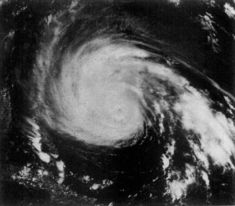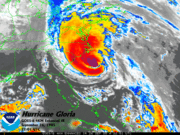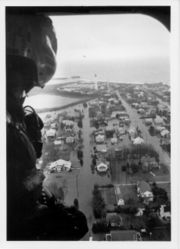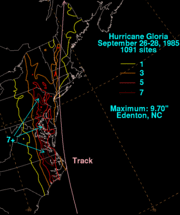Hurricane Gloria
2008/9 Schools Wikipedia Selection. Related subjects: Storms
| Category 4 hurricane ( SSHS) | ||
|---|---|---|
|
Gloria near peak intensity on September 25 |
||
| Formed | September 16, 1985 | |
| Dissipated | October 2, 1985 | |
| Highest winds |
|
|
| Lowest pressure | 919 mbar ( hPa; 27.15 inHg) | |
| Fatalities | 8 direct | |
| Damage | $900 million (1985 USD) $1.803 billion (2008 USD) |
|
| Areas affected |
North Carolina, New Jersey, Long Island, New England, Atlantic Canada | |
| Part of the 1985 Atlantic hurricane season |
||
Hurricane Gloria was a powerful Cape Verde-type hurricane that formed during the 1985 Atlantic hurricane season and prowled the Atlantic Ocean from September 16 to September 28. Gloria reached Category 4 on the Saffir-Simpson Hurricane Scale near the Bahamas, but weakened significantly by the time it made landfall on North Carolina's Outer Banks. From there, Gloria closely followed the Mid-Atlantic coastline and made a second landfall on Long Island, New York, and, after crossing the Long Island Sound, it made a third landfall in Connecticut.
Overall, the storm caused extensive damage along the East Coast of the United States, amounting to $900 million ($1.6 billion in 2005 USD), and was responsible for 8 fatalities. The storm was the first significant system to impact the northeastern United States since Hurricane Agnes in 1972 and the first major storm to affect New York and Long Island directly since Hurricane Donna in 1960. It was the last storm to hit the northeast until Hurricane Bob in 1991.
Storm history
Gloria began as a tropical wave that moved off the coast of Africa on September 15. It moved westward through the favorable tropical Atlantic Ocean, and organized into a tropical depression the next day while south of the Cape Verde Islands. Tracking steadily west-northwestward due to the strong subtropical ridge, the depression continued to strengthen and became Tropical Storm Gloria on the 17th. Conditions for tropical development deteriorated, causing Gloria to weaken to a tropical depression on the 18th. After it crossed 45°W on the 20th, the system was able to restrengthen to a tropical storm, and steadily intensified as it approached the Lesser Antilles. While 620 miles (1000 km) east-southeast of St. Croix, Gloria attained hurricane status.
Moving westward, Gloria threatened much of the Leeward Islands, prompting the islands' respective governments to issue Hurricane Warnings in anticipation of the storm. A turn to the west-northwest occurred on September 22, and the hurricane passed 155 miles (250 km) to the north of Anegada, the northernmost island in the Lesser Antilles. A break in the subtropical ridge, caused by Tropical Storms Fabian and Henri, was responsible for the northward turn and caused Gloria to take a northwest track. While passing to the northeast of the Bahamas, Gloria strengthened significantly in very favorable conditions, reaching major hurricane status on the 24th and peak wind speeds of 145 mph (235 km/h) and a central pressure of 919 mbar on the 25th. This is the second lowest pressure ever recorded in an Atlantic hurricane that never reached Category 5 status, only second to Hurricane Opal of the 1995 season.
Shortly after peaking, Gloria's asymmetrical wind field caused the storm to rapidly weaken, and its winds decreased to 90 mph (145 km/h) after 18 hours. Continuing around the periphery of the subtropical ridge, the hurricane turned to the north-northeast, and its winds strengthened to 105 mph (170 km/h) as it passed over the warm waters of the Gulf Stream. Gloria then struck Cape Hatteras, North Carolina early on September 26, with winds of 105 mph (170 km/h) and a pressure of 942 mbar while accelerating to the northeast. Gloria became the strongest recorded hurricane to strike the U.S. East Coast so far north, a distinction it still holds. It paralleled the coastlines of Virginia, Maryland, Delaware, and New Jersey, coming within miles of land.
Gloria made its final landfall on western Long Island near Long Beach, New York as a weaker yet still strong hurricane just 10 hours after hitting the Outer Banks. Originally, the National Hurricane Centre classified Gloria as a major hurricane upon making landfall but it was later downgraded in the seasonal post-analysis. Even so, the hurricane did produce Category Three wind gusts throughout Long Island. Shortly thereafter the storm crossed the Connecticut coastline near Bridgeport, and while continuing northeastward through New England, it became extratropical over Maine early on the 28th. After moving through Atlantic Canada, the extratropical storm tracked eastward before dissipating on October 2 to the southwest of Iceland.
Preparations
As Gloria approached the East Coast of the United States, National Hurricane Centre director Neil Frank called it the "Storm of the Century", due to its intensity and potential track over the densely populated area of New England. Such a track greatly gathered the attention of many people, and led to the evacuation of 380,000 people along the coast from North Carolina to Connecticut. In Maryland, for example, officials implemented lane reversing to expedite the evacuation process, a policy many other coastal states use.
Officials recommended 95,000 citizens along the New Jersey coastline, an area that rarely experiences hurricanes, to evacuate. Cape May County, the most vulnerable part of the state and among the most susceptible in the entire country, would require 36 hours in 2005 to evacuate the 100,000 citizens and 900,000 tourists that were commonly present during busy summer weekends. 397 unofficial shelters existed in the county in 1985 for the preparation of Hurricane Gloria, of which 150 were located on boardwalks; if the hurricane were to strike, only a small area in the northwest part of the county would be safe from the storm surge. Due to its vulnerability, an evacuation of the entire county would be required to avoid significant human losses in future hurricanes.
Offices and classes of Harvard University closed only for the third time in the 20th century, the previous cases being the New England Hurricane of 1938 and the Blizzard of '78. Although Gloria's winds downed numerous trees and caused tens of thousands in damage in the area, overall effects were much less than expected.
Impact
Hurricane Gloria was a large hurricane that affected much of the northeastern United States. Gloria brought strong wind gusts to the area, downing thousands of trees and leaving over 2 million people without power. Overall, Gloria caused $900 million (1985 USD) in property damage and 8 deaths, a total lower than expected due to the hurricane's arrival at low tide.
Carolinas and Mid-Atlantic
Upon making landfall on the Outer Banks, Gloria was a fast-moving hurricane that struck at low tide, reducing storm surges to a maximum of 6 ft (1.8 m) in North Carolina. Other locations from South Carolina through New Jersey reported surges less than 1 – 5 feet (0.3 – 1.5 m) high. Similarly, winds were relatively minimal and confined to the coast. Diamond Shoal Light reported sustained winds of 100 mph (160 km/h), and Cape Hatteras, where the storm's eye came ashore, experienced 75 mph (120 km/h) winds. Much of the Mid-Atlantic coastline was largely unscathed from Gloria's winds, excluding a report of 90 mph (145 km/h) on the Chesapeake Bay Bridge-Tunnel and a report of 80 mph (130 km/h) in Ocean City, New Jersey. Though Gloria moved quickly through the region, it dropped moderate rainfall in locations, including peaks of 7.09 inches (180 mm) in New Bern, North Carolina and 6.04 inches (153 mm) at Baltimore-Washington International Airport. In addition, some unofficial reports in southeastern Virginia indicated amounts of up to 8 inches (200 mm) of rain.
Because much of the Mid-Atlantic experienced the western, weaker side of this hurricane, damage was relatively light. High winds downed numerous trees throughout the area, leaving hundreds of thousands without power, including 237,000 in New Jersey, 124,000 in Maryland, and 56,000 in Virginia. Extreme rainfall in Virginia resulted in $5.5 million (1985 USD, $9.8 million 2005 USD) in damage. Intense flood waters split Long Beach Island in half for a period of time. The hurricane's winds caused significant beach erosion, the area most affected being the Outer Banks.
Long Island and New York
Though Gloria hit Long Island with winds of 95 to 100 mph (135 km/h), wind gusts reached up to 115 mph (185 km/h) in eastern Long Island. Islip, New York recorded a wind gust of 85 mph (135 km/h). However, few other wind reports were available from the island as Gloria winds knocked out weather instruments. Weather forecasters believe that damage across parts of Long Island indicated winds in the Category Three range, as evidence of the damaged received at MacArthur Airport. Because the hurricane arrived at low tide, storm surges were generally low, peaking at 6.9 feet (2.1 m) at Battery Park. Because it moved quickly, Gloria failed to produce significant rainfall amounts, and caused only 3.4 inches (86 mm) of rain in Central Park.
Gloria's high winds caused significant damage across Long Island and southeastern New York. The area hit the worst was eastern Long Island, where high wind gusts blew thousands of trees into buildings and across roads. In addition, the winds ripped roofs off of many buildings, including hangars at the MacArthur Airport and the roof of the Islip Police Station. Prolonged exposure to high winds and waves led to moderate beach erosion, washing away several piers and docks. The storm surge, though relatively weak, destroyed 48 houses on the ocean side of the island. Gloria's high winds left 683,000 people in New York without power, with some lacking electricity for over eleven days. Even though damage amounted to $300 million ($532 million in 2005 USD), due to well-executed evacuations there was only one casualty, the death occurring from a falling tree.
New England
Upon making landfall in Milford, Connecticut, Gloria was a weakened hurricane that passed quickly through the area. Though still a large hurricane, Gloria hit at low tide, resulting in low to moderate storm surges of 5 feet (1.5 m) in Groton, Connecticut, 6 feet (1.8 m) in New Bedford, Massachusetts, and 1 foot (.3 m) in Portland, Maine. The hurricane produced gusty winds across New England, with a peak observation of 83 mph (135 km/h) in Waterbury, Connecticut and Blue Hill, Connecticut. Gloria dropped moderate precipitation in the area amounting to a maximum of 6 inches (150 mm) in Littleville Lake, Massachusetts. In addition, Gloria caused significant beach erosion in Connecticut and Rhode Island.
Gloria's high winds downed numerous trees across New England, causing minor to moderate damage. In the region, Connecticut received the worst of the hurricane, where tree and structural damage was greatest. Along the coastline, storm surge and strong waves washed away several fishing piers, and some roadways were underwater during the storm's passage. The hurricane did not pass close enough to Rhode Island and parts of Massachusetts, so these areas did not receive significant damage. New Hampshire was affected only slightly from the hurricane, and was limited to minor wind damage and localized flooding. In Maine, damage was more severe, where strong wind gusts ripped off roofs and uprooted hundreds of trees. High winds across New England resulted in significant power outages, leaving 250,000 in Maine, 84,000 in Massachusetts, 174,000 in Rhode Island, and 669,000 in Connecticut without power. In all, 7 deaths occurred in New England, many of which occurred from falling tree limbs.
Canada
The extratropical remnants caused minimal damage in Nova Scotia and produced tropical storm force winds across southern Newfoundland.
Aftermath
In the immediate aftermath in New York, hundreds of thousands had great difficulty living their everyday lives without power. The long duration without electricity led to a general disdain for the Long Island Lighting Company. This increased further when the company left the $40 million (1985 USD) repair bill to the ratepayers, citing the company didn't have hurricane insurance. Citizens quickly protested this privately owned company, and within years the publicly owned Long Island Power Authority was formed.
In Maine, most citizens remained indoors during the passage of the hurricane. One police officer noted that even the criminals stayed home. In the Lewiston area, restaurants experienced a great surge in business. During the power outage after the storm, several businesses stored frozen goods for houses without a generator.
After the storm, President Ronald Reagan declared several counties in New Jersey, Pennsylvania, New York, Rhode Island, Connecticut, and Massachusetts as federal disaster areas. This declaration allowed those counties to apply for disaster assistance.
Due to its impact, the name Gloria was retired from the Atlantic tropical storm name list in the spring of 1986, so it will never again be used for an Atlantic hurricane. It was replaced with Grace in the 1991 season.





